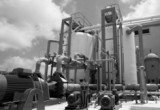Optimising Cooling Tower Efficiency Through Water Filtration
IWC explains how the right cooling tower water filtration system can reduce operational problems, save water and energy and save the end user money that can be spent elsewhere
Online, June 13, 2014 (Newswire.com) - The environmental impact of industrial water cooling towers is coming under increased regulatory scrutiny as government bodies across the world endeavour to clean up the planet's air and water resources. Accordingly, ensuring cooling tower systems are operating at optimum efficiencies is the goal for all system owners/operators.
Crucial to achieving this is to ensure cooling water in the recirculating flow rate is kept as clean as possible throughout the cycle. This is because cooling tower systems are most efficient when heat transfer surfaces within them and heat exchanger equipment, like plate heat exchangers, are clean and free from suspended solids, the presence of which leads to four main water treatment issues: corrosion, scaling, fouling and microbiological activity. A cost-effective method of preventing the build-up of solids and thus addressing these issues is through water filtration.
IWC, specialists in evaporative water cooling systems, are the leading suppliers of water filtration systems in Sub-Saharan Africa.
IWC offers fully integrated solutions, from cooling towers to glass-reinforced plastic (GRP) manufacturing and plate heat exchangers (PHE) supplied by SONDEX. The company's range of products are packaged cooling towers, large field erected-and-mechanical draught cooling towers, natural draught cooling towers as well as the refurbishment thereof.
Suspended solids: the bane of cooling towers
The bane of industrial cooling tower system operators, in relation to efficient heat transfer and pathological risks to employees, is suspended solids within the water system.
Suspended solids (or unclean water) in the cooling tower system reduce efficiency in the following ways:
● A higher flow of water is required to remove heat when heat transfer efficiency is reduced, leading to increased energy usage (and higher costs) for more pumping capacity.
● The nozzles in counter-flow cooling towers become clogged with organic or inorganic debris, resulting in an irregular distribution of water across the fill media, which then leads to uneven cooling and loss of efficient heat transfer to the atmosphere. Labour intensive maintenance is required to remove this debris, leading to loss of production.
● In cooling towers that contain packing (used to form a thin liquid film that increases the surface area of the water/air interface for more efficient heat transfer), the suspended solids can block passages in this packing, thus decreasing the surface area for heat transfer and creating a more conducive environment for the growth of microbiological materials such as algae, moss, and even deadly pathogens such as Legionella pneumophila.
● The entire cooling tower system will need to be shut-down for cleaning if solids settle within the tower basin. Often unscheduled, these shut-downs can be very costly, especially if production is lost. Additionally, accumulated sediments provide the perfect breeding ground for algae, bacteria and other organisms; including Legionella pneumophila.
● Abrasive solids can cause accelerated erosion of pumps, piping, valves, fittings, heat exchangers and other mechanical parts, resulting in frequent repairs or premature capital replacement costs.
Choosing a filtration system
A filtration system can address all the above-mentioned issues caused by unclean water in the cooling tower system.
Two of the most common filtration systems used within cooling towers are full flow and side stream. In a full flow system, the filter is installed before the cooling tower, on the discharge side of the pump, and continuously filters all of the recirculating water. This means that the filter must be sized in order to handle the system's design recirculation rate.
A cheaper alternative that can easily improve the water quality is side stream filtration whereby the filter continuously draws off a percentage of the cooling water, filters it to remove the suspended solids, organic materials and silt particles and then returns it back to the cooling water system. This process reduces the chance of fouling as well as biological growth, which in turn assists to control corrosion and scaling.
Unlike full flow filtration, side stream filtration systems can be cleaned while the cooling systems are online, avoiding the need for system downtime.
Benefits of side stream sand filtration
Side stream sand filter systems are the most common type of filtration used in industrial cooling tower applications. They work by directing water through a bed of graded filter media, usually made up of compounds such as silica, anthracite or garnet. As the water flows through the bed of sand media, suspended solids and other particles are captured within the upper layer of media. The water moves downward, passing into a drain at the bottom of the filter tank and is discharged from the tower through an outlet pipe.
Real benefits exist from the installation of side stream filters particularly on large industrial cooling towers. Reductions in operating costs for the process plant operator/owner are derived from:
● Reduction in use of water treatment chemicals
● Increased cooling tower and heat exchanger operational life
● Lower maintenance costs
● Reduced down time
● Less water discharged from the cooling water circuit
● Increased durations of operational efficiency due to reduction of scale formation on heat transfer surfaces resulting in real long term energy savings.
In short, cleaner cooling tower water reduces operational problems, saves water and energy by optimising the system and saves the end user money that can be spent elsewhere.

